Sony RMO-S551 User Manual
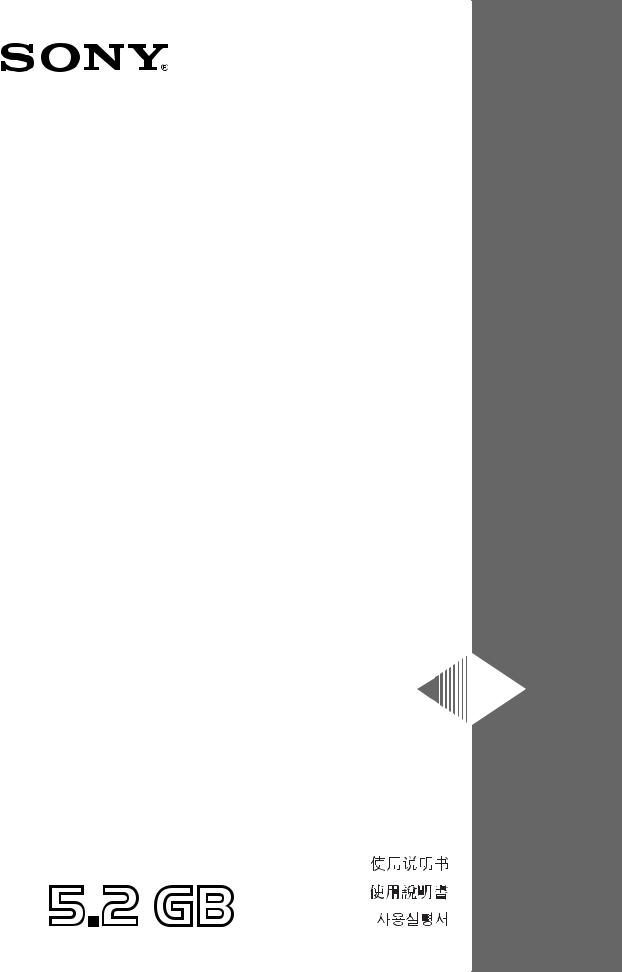
3-862-813-17(1)
MO Disk Unit RMO-S551
User’s Guide
Mode d’emploi
Bedienungsanleitung
Guía del usuario
Istruzioni per l’uso

Safety Regulations
Owner’s Record
The model and serial numbers are located on the bottom of the unit. Record the serial number in the space provided below.
Refer to them whenever you call upon your Sony dealer regarding this product.
Model No. RMO-S551
Serial No._________________________
Information
For the customer in the U.S.A.
You are cautioned that any changes or modifications not expressly approved in this manual could void your authority to operate this equipment.
This equipment has been tested and found to comply with the limits for a Class B digital device, pursuant to Part 15 of the FCC Rules. These limits are designed to provide reasonable protection against harmful interference in a residential installation. This equipment generates, uses, and can radiate radio frequency energy and, if not installed and used in accordance with the instructions, may cause harmful interference to radio communications. However, there is no guarantee that interference will not occur in a particular installation. If this equipment does cause harmful interference to radio or television reception, which can be determined by turning the equipment off and on, the user is encouraged to try to correct the interference by one or more of the following measures:
–Reorient or relocate the receiving antenna. –Increase the separation between the equipment
and receiver.
–Connect the equipment into an outlet on a circuit different from that to which the receiver is connected.
–Consult the dealer or an experienced radio/TV technician for help.
This device requires shielded interface cables to comply with FCC emission limits.
WARNING
To reduce the risk of fire or electric shock, do not expose this apparatus to rain or moisture.
To avoid electrical shock, do not open the cabinet. Refer servicing to qualified personnel only.
CAUTION
As the laser beam used in the RMO-S551 is harmful to the eyes, do not attempt to disassemble the unit.
Refer servicing to qualified personnel only. The use of controls or adjustments or performance of procedures other than those specified herein may result in hazardous radiation exposure.
This label is affixed inside the unit.
CAUTION CLASS 3B LASER RADIATION WHEN OPEN. AVOID DIRECT EXPOSURE TO THE BEAM.
ATTENTION RADIATIONS LASER DE CLASSE 3B EN CAS D'OUVERTURE. EVITER TOUTE EXPOSITION DIRECTE AU FAISCEAU.
VORSICHT KLASSE 3B LASERSTRAHLUNG WENN GEÖFFNET. DIREKTEN KONTAKT MIT DEM STRAHL VERMEIDEN.
ADVARSEL LASERSTRÅLING AF KLASSE 3B VED ÅBNING. UNDGÅ DIREKTE UDSÆTTELSE FOR STRÅLING.
ADVARSEL LASERSTRÅLING I KLASSE 3B NÅR DEKSEL ÅPNES. UNNGÅ DIREKTE EKSPONERING FOR STRÅLEN.
VARNING KLASS 3B LASERSTRÅLNING NÄR DENNA DEL ÄR ÖPPNAD. UNDVIK ATT DIREKT EXPONERA DIG FÖR STRÅLNINGEN.
VARO! AVATTUNA LUOKAN 3B LASERSÄTEILYÄ. VÄLTÄ SUORAA ALTISTUMISTA SÄTEELLE.
This MO disk unit is classified as a CLASS 1 LASER PRODUCT.
The CLASS 1 LASER PRODUCT label is located on the bottom exterior.
CLASS 1
LASER PRODUCT
LASER KLASSE 1
PRODUKT
LUOKAN 1 LASERLAITE
KLASS 1 LASER APPARAT
2
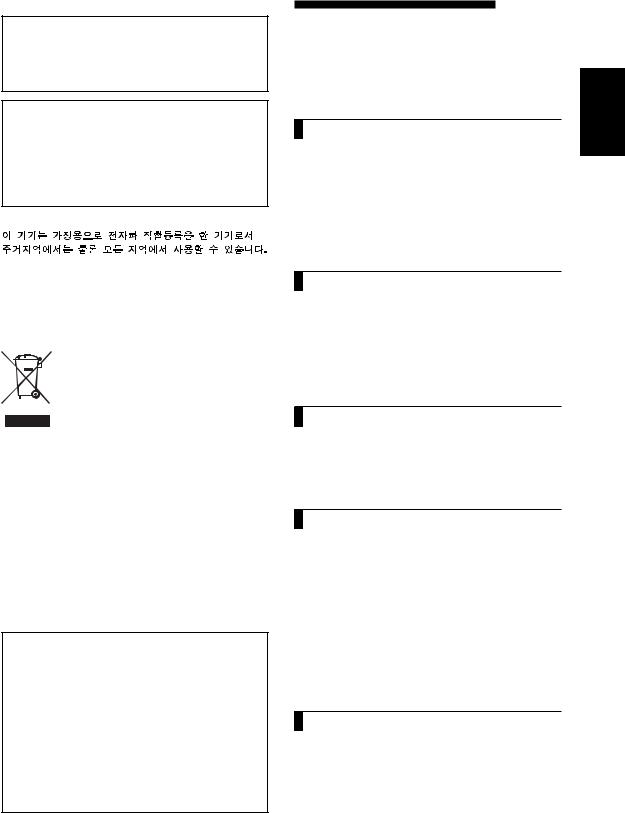
NOTICE
Use the power cord set approved by the appropriate testing organization for the specific countries where this unit is to be used.
CAUTION
The mains plug on this equipment must be used to disconnect mains power.
Please ensure that the socket outlet is installed near the equipment and shall be easily accessible.
Disposal of Old Electrical & Electronic Equipment (Applicable in the European Union and other European countries with separate collection systems)
This symbol on the product or on its packaging indicates that this product shall not be treated as household waste. Instead it shall be handed over
to the applicable collection point for the recycling of electrical and
electronic equipment. By ensuring this product is disposed of correctly, you will help prevent potential negative consequences for the environment and human health, which could otherwise be caused by inappropriate waste handling of this product. The recycling of materials will help to conserve natural resources. For more detailed information about recycling of this product, please contact your local Civic Office, your household waste disposal service or the shop where you purchased the product.
According to the EU Directives related to product safety, EMC and R&TTE the manufacturer of this product is Sony Corporation, 6-7-35 Kitashinagawa Shinagawa-ku Tokyo, 141-0001 Japan. The Authorised Representative is Sony Deutschland GmbH, Hedelfinger Strasse 61,70327 Stuttgart, Germany.
For any service or guarantee matters please refer to the addresses given in separate service or guarantee documents.
Table of Contents |
|
Using this Guide........................................ |
4 |
Chapter 1 Introduction |
|
Overview .................................................... |
5 |
Features ....................................................... |
5 |
Compatible Disks ....................................... |
6 |
System Configuration ................................. |
6 |
Location and Function of Parts ............... |
7 |
Chapter 2 Getting Started |
|
Component and Accessory Check List .. |
8 |
Connecting the Disk Unit ......................... |
9 |
Setting the SCSI ID.................................... |
9 |
Setting the Disk Unit’s Functions .......... |
10 |
Chapter 3 Using the Disk Unit |
|
Inserting a Disk Cartridge ...................... |
11 |
Ejecting a Disk Cartridge........................ |
12 |
Chapter 4 Precautions |
|
On the Disk Unit ...................................... |
13 |
Safety Considerations ............................... |
13 |
Damage Prevention .................................. |
13 |
Other Points Requiring Attention ............. |
14 |
On the Disk Cartridges ........................... |
14 |
Protecting Your Data ................................ |
15 |
Cleaning ................................................... |
15 |
Cleaning a Disk ........................................ |
15 |
Appendix |
|
Specifications .......................................... |
16 |
Disk Unit .................................................. |
16 |
Optional Accessories ................................ |
17 |
English
3

Using this Guide
This guide covers the use and operation of the RMO-S551 Magneto-Optical Disk Unit (called the “disk unit” thereafter). Do not attempt to use the disk unit without first carefully reading this guide. When finished, keep it handy for future reference.
The guide is divided into the following sections.
Chapter 1 Introduction
This chapter contains a general overview of the RMO-S551 disk unit, touching upon its features, system configuration, and the location and function of its parts.
Chapter 2 Getting Started
This chapter explains how to connect the disk unit to the host computer and other SCSI peripheral devices. It also explains how to set the disk unit’s functions and the SCSI ID. Refer to this chapter when setting up the disk unit.
Chapter 3 Using the Disk Unit
In this chapter, you learn how to turn on the disk unit, and how to insert and eject a disk cartridge. Refer to this chapter when you are ready to actually begin using the disk unit.
Chapter 4 Precautions
This chapter contains precautions regarding the use and operation of the disk unit and magnetooptical disk cartridges.
It also discusses cleaning of disks.
Be sure to refer to this chapter before using the disk unit.
Appendix
The Appendix contains an explanation of the disk unit’s main specifications.
Notes
•The manufacturer disclaims all responsibility for any losses incurred through malfunction or use of this product.
•The manufacturer does not warrant the security of data stored using this product. To guard accidental data loss, frequent backup of important data is highly recommended.
•Reproduction of the contents of this manual, in whole or in part, is prohibited.
•Macintosh is a registered trademark of Apple Computer, Inc.
•Microsoft and Windows are registered trademarks of Microsoft Corporation.
4

 Chapter 1 Introduction
Chapter 1 Introduction
Overview
Features
The RMO-S551 Magneto-Optical Disk Unit has the following features:
•Magneto-optical technology enables repeated writing and erasing of data on the disk.
•The disk unit automatically senses the type of disk being inserted, enabling the free use of both 650 Mbytes (594 Mbytes), 1.3 Gbytes (1.2 Gbytes), 2.6 Gbytes (2.3 Gbytes), and 5.2 Gbytes (4.8 Gbytes, 4.1 Gbytes) disks indifferently.
•A maximum of 5.2 Gbytes (2,048 bytes/sector), 4.8 Gbytes (1,024 bytes/sector), or 4.1 Gbytes (512 bytes/sector) of data can be written on the two sides of a 5.25-inch magneto-optical disk. This is equivalent to about 2900–3700 times the capacity of a conventional 3.5-inch floppy disk (2HD).
•Any disk conforming to the internationally accepted CCS (continuous/composite servo) or CCW (continuous composite write-once) format can be used in this disk unit.
•This disk unit employs SCSI-2 (Small Computer System Interface-2).
•The 3,300 min-1 (3,300 rpm) high-speed spindle motor enables data transfer rates of
2.48– 5.07 Mbytes/s (2,048 bytes/sector),
2.31– 4.79 Mbytes/s (1,024 bytes/sector), or
1.97– 4.06 Mbytes/s (512 bytes/sector).
•With disk capacities under 2.6 Gbytes (2.3 Gbytes), the spindle motor rotates at 3600 min-1 (rpm).
•The low-profile, light-weight optical pick-up yields average seek times of 25ms.
•Use of a highly reliable error correction code (ECC) system keeps the error rate as low as 10-12.
•Optimum operation environment is provided through use of a large, 4MB buffer and optimized cache control algorithm. (Write cache can be enabled or disabled. For details, see “Setting the Disk Unit’s Functions” on page 10.)
Chapter 1 Introduction |
5 |

Compatible Disks
The RMO-S551 can use the following Sony 5.25-inch MO Disks:
Standard |
Sector format |
Type* |
Capacity |
Sony equivalent |
|
|
|
|
|
|
|
ISO/IEC 15286 |
2048 |
bytes/sector |
R/W |
About 5.2 G bytes |
EDM-5200B |
|
|
|
|
|
|
ISO/IEC 15286 |
1024 |
bytes/sector |
R/W |
About 4.8 G bytes |
EDM-4800B |
|
|
|
|
|
|
ISO/IEC 15286 |
512 |
bytes/sector |
R/W |
About 4.1 G bytes |
EDM-4100B |
|
|
|
|
|
|
ISO/IEC 14517 |
1024 |
bytes/sector |
R/W |
About 2.6 G bytes |
EDM-2600B |
|
|
|
|
|
|
ISO/IEC 14517 |
512 |
bytes/sector |
R/W |
About 2.3 G bytes |
EDM-2300B |
|
|
|
|
|
|
ISO/IEC 13549 |
1024 |
bytes/sector |
R |
About 1.3 G bytes |
EDM-1300B |
|
|
|
|
|
|
ISO/IEC 13549 |
512 |
bytes/sector |
R |
About 1.2 G bytes |
EDM-1200B |
|
|
|
|
|
|
ISO/IEC 10089 |
1024 |
bytes/sector |
R |
About 650 M bytes |
EDM-650B |
|
|
|
|
|
|
ISO/IEC 10089 |
512 |
bytes/sector |
R |
About 600 M bytes |
EDM-600B |
|
|
|
|
|
|
ISO/IEC 15286 |
2048 |
bytes/sector |
WO |
About 5.2 G bytes |
CWO-5200B |
|
|
|
|
|
|
ISO/IEC 15286 |
1024 |
bytes/sector |
WO |
About 4.8 G bytes |
CWO-4800B |
|
|
|
|
|
|
ISO/IEC 15286 |
512 |
bytes/sector |
WO |
About 4.1 G bytes |
CWO-4100B |
|
|
|
|
|
|
ISO/IEC 14517 |
1024 |
bytes/sector |
WO |
About 2.6 G bytes |
CWO-2600B |
|
|
|
|
|
|
ISO/IEC 14517 |
512 |
bytes/sector |
WO |
About 2.3 G bytes |
CWO-2300B |
|
|
|
|
|
|
ISO/IEC 13549 |
1024 |
bytes/sector |
R |
About 1.3 G bytes |
CWO-1300B |
|
|
|
|
|
|
ISO/IEC 13549 |
512 |
bytes/sector |
R |
About 1.2 G bytes |
CWO-1200B |
|
|
|
|
|
|
ISO/IEC 11560 |
1024 |
bytes/sector |
R |
About 650 M bytes |
CWO-650B |
|
|
|
|
|
|
ISO/IEC 11560 |
512 |
bytes/sector |
R |
About 600 M bytes |
CWO-600B |
|
|
|
|
|
|
*R/W:Rewritable, R/W:Rewritable(MO), WO:Write Once, R:Read Only
System Configuration
The disk unit should be used with a host computer equipped with SCSI.
A maximum of seven peripheral devices can be linked in a daisy chain on the SCSI bus, and controlled with SCSI-2 commands.
Host computer
SCSI cable
|
|
|
|
RMO-S551 disk unit |
SCSI peripheral devices |
||
6 Chapter 1 Introduction

Location and Function of Parts
Front Panel |
|
Rear Panel |
1 |
A B C D E F G H |
AC IN |
|
||
BUSY |
|
SCSI ID |
0
POWER
SCSI CONNECTOR |
F.GND |
EJECT |
|
1 POWER switch 1 Function switches
Push the button to turn the power on and off. The power is on when the button is in the depressed position, and off when fully protruding.
2 POWER indicator
The green lamp lights up when the power is turned on.
3 BUSY indicator
As this disk is inserted and the drive becomes ready for read/write operation, the BUSY indicator turns green. The orange lamp lights up when the disk unit is accessing or writing data. This lamp flashes on and off at about 2- second intervals when the unit overheats, regardless of whether or not a disk is being accessed.
4 Disk insertion slot
Insert the disk cartridge into this slot. Refer to the section “Inserting a Disk Cartridge” on page 11 for more information.
5 Emergency eject hole
If the disk cartridge cannot be ejected using the EJECT button 6, turn off the power and insert the supplied emergency eject tool into this hole to trip the emergency eject mechanism. Refer to the section “What to do if the disk does not eject” on page 12 for further details.
6 EJECT button
Press this button to eject the disk cartridge from the disk unit. The EJECT button is disabled with the function switch or software settings prohibit ejection. When the write cache is enabled, it may take a few moments (up to 45 seconds) for the disk to eject because data in the cache must first be written to the disk.
Use this switches to set the disk unit’s functions in accordance with the host computer and software being used. Refer to the section“Setting the Disk Unit’s Functions” on page 10 for more information.
2 SCSI ID switch
Use these switches to set the SCSI ID. Push the “–” button to lower the ID number; push the “+” button to raise the ID number. Refer to the section“Setting the SCSI ID”on page 9 for more information.
3 SCSI connectors
Plug SCSI cables (sold separately) linking the host computer and other SCSI peripherals into these connectors.
Note
If the disk unit is the last device on the SCSI chain, set function switch F to “1” to turn on the internal terminator. When it is not the last device, make sure that the terminator is off (switch F is set to “0”).
4 Air duct
The air for cooling the disk unit flows through this duct, so be careful not to block its surface or impede the outflow.
5 F.GND (frame ground) terminal
Connect the ground terminals of other devices to the disk unit’s frame ground.
6 AC IN (AC power) connector
Connect the supplied AC power cord to this connector.
Chapter 1 Introduction |
7 |
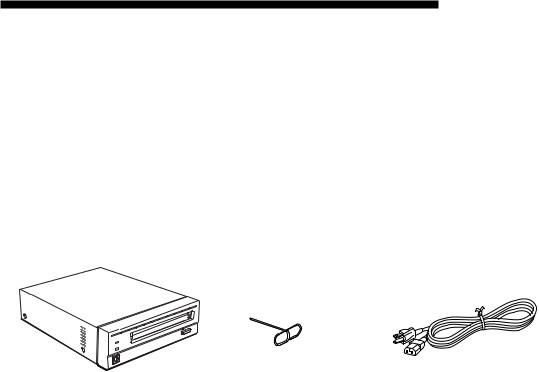
 Chapter 2 Getting Started
Chapter 2 Getting Started
Before setting up your RMO-S551 MagnetoOptical Disk Unit, check to see that you have all the required components and accessories. Then, connect the disk unit to the host computer and any other SCSI peripherals you may be using.
After checking to see that all the connections have been properly made, set the SCSI ID using the SCSI ID switch and the disk unit’s functions using the function switches.
Component and Accessory Check List
Upon opening the carton, check to see that you have all of the components and accessories listed below. Contact your dealer immediately if you find any missing or damaged items.
•RMO-S551 Magneto-Optical Disk Unit
•AC power cord
•Emergency eject tool
•User’s Guide
•Guide to Safe Use (Safety Precautions)
•1 Blank MO disk (EDM-5200B)
Note
Please refer to the installation manual included in the device driver’s package for instructions when using this device with a Macintosh® computer or a computer running under Windows® system. For questions concerning the device drivers, please contact the device driver manufacturer as indicated in the device driver package.
RMO-S551 |
Emergency eject tool |
AC Power cord |
Magneto-Optical Disk Unit |
|
|
|
|
|
8 Chapter 2 Getting Started
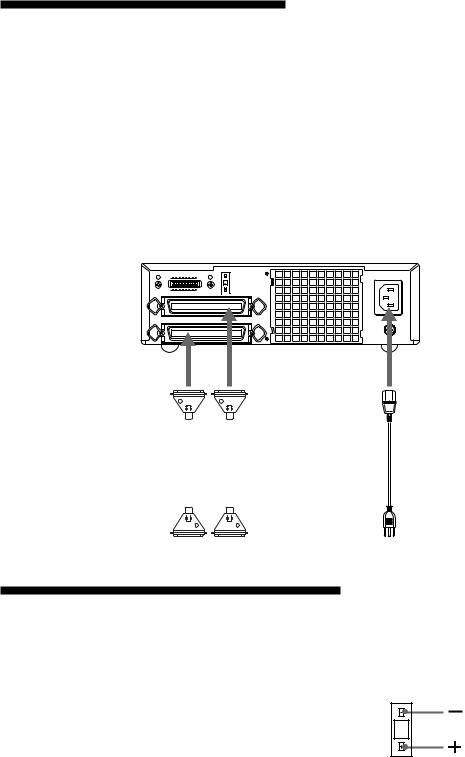
Connecting the Disk Unit
You can hook up a maximum of seven SCSI peripheral devices to a single host computer through its SCSI bus.
Use the following Sony SCSI cable to connect the disk unit.
Notes
•Before connecting the disk unit, be sure to turn off the disk unit and all other devices on the SCSI chain.
•If the disk unit is the last device on the SCSI chain, set the function switch F on the rear panel to “1” to turn on the internal terminator. When it is not the last device, make sure that the terminator is off (function switch F is set to “0”).
•The total length of the SCSI cables connected to a SCSI chain must not exceed six meters (19 feet 8 1/4 inches).
RMO-S551 Magneto-Optical Disk Unit
A B C D E F G H |
AC IN |
1 |
|
|
SCSI ID |
0 |
|
SCSI CONNECTOR |
F.GND |
to SCSI connector |
to AC IN |
|
connector |
SCSI cable |
|
|
|
SCSI cable |
|
AC power cord |
|
|
|
|
|
|
|
|
|
|
|
|
|
(supplied) |
|
|
|
|
|
|
|
|
|
|
|
|
|
|
to another |
to the host computer or |
to an AC outlet |
|
SCSI device |
another SCSI device |
||
|
Setting the SCSI ID
The factory default setting for the SCSI ID is “0.” If necessary, this ID number can be changed using the SCSI ID switch on the rear panel. Be sure to turn off the power before making any changes.
Pushing the “+” button raises the ID number; pushing the “–” button lowers the ID number.
Notes
•The disk unit will not operate properly unless the SCSI ID has been set correctly.
•Make sure to select a SCSI ID that has not been assigned to another SCSI device.
0
Chapter 2 Getting Started |
9 |
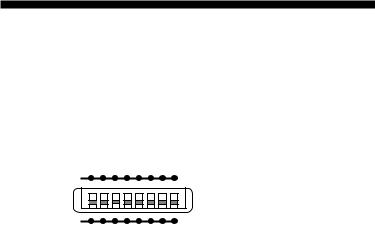
Setting the Disk Unit’s Functions
Use function switches (A – H) on the rear panel to select the disk unit’s functions in accordance with the host computer and software you are using. Be sure to turn off the power before setting the switches.
A B C D E F G H
1
0
This disk unit is equipped with a write cache. When the write cache is enabled, never turn off the disk unit power without making sure that all data has been written to the disk from cache memory. Data will be lost if you turn off the power before all data in cache memory has been written to the disk.
Before powering off the disk unit, be sure to eject the disk. Ejecting the disk writes data from cache memory to the disk.
|
|
Note |
|
|
|
|
|
Even though the drive will flush data periodically |
|||
|
|
to the disk, data may be lost in the case of a |
|||
|
|
power failure. |
|
|
|
|
|
Function Switch Settings |
|
|
|
|
|
|
|
|
|
Switch |
Function |
|
|
|
|
1 |
0 |
||||
|
|
||||
A |
Parity check |
SCSI parity check is disabled. |
SCSI parity check is |
||
|
|
|
enabled. |
||
B |
Device type |
Peripheral device type 00H |
Peripheral device type 07H |
||
|
|
(Direct Access Device) |
(Optical Memory Device) |
||
C |
Write cache control |
Disable write cache. |
Enable write cache. |
||
D |
Fast SCSI control |
Fast SCSI compatible |
Not Fast SCSI compatible |
||
E |
Force verify |
All write operations are verfied. |
All write operations are |
||
|
|
|
normal operations. |
||
|
|
(with a verify pass) |
(without a verify pass) |
||
F |
Terminator |
The internal terminator is on. |
The internal terminator is off. |
||
G |
Auto spin up |
Inserting a disk does not causes |
Inserting a disk causes |
||
|
|
the spindle motor to rotate. |
the spindle motor to rotate. |
||
H |
Manual eject |
Disk catridge cannot be ejected |
Disk cartridge can be |
||
|
|
by pressing the EJECT button. |
ejected by pressing the |
||
|
|
|
EJECT button |
||
|
|
|
|
: Factory setting |
|
|
|
|
|
||
10 Chapter 2 Getting Started
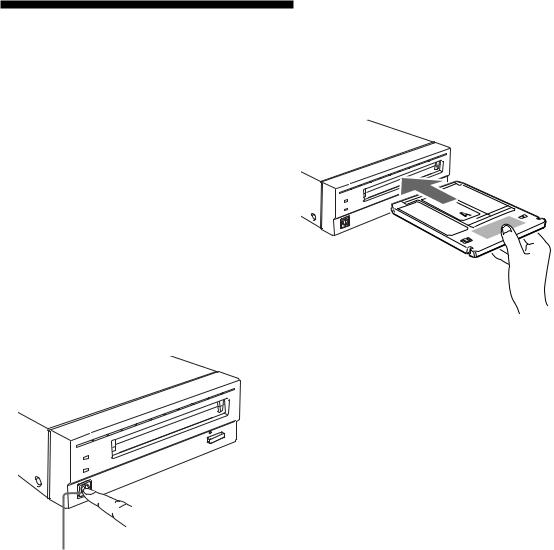
 Chapter 3 Using the Disk Unit
Chapter 3 Using the Disk Unit
Inserting a Disk Cartridge
Use the following Sony 5.25-inch MO disks in your RMO-S551 disk unit.
•EDM-5200B (2,048 bytes/sector, 5.2 Gbytes)
•EDM-4800B (1,024 bytes/sector, 4.8 Gbytes)
•EDM-4100B (512 bytes/sector, 4.1 Gbytes)
•EDM-2600B (1,024 bytes/sector, 2.6 Gbytes)
•EDM-2300B (512 bytes/sector, 2.3 Gbytes)
•CWO-5200B (2,048 bytes/sector, 5.2 Gbytes )
•CWO-4800B (1,024 bytes/sector, 4.8 Gbytes)
•CWO-4100B (512 bytes/sector, 4.1 Gbytes)
•CWO-2600B (1,024 bytes/sector, 2.6 Gbytes )
•CWO-2300B (512 bytes/sector, 2.3 Gbytes)
1 Press the POWER switch located on the left side of the front panel.
This turns on the disk unit and causes the POWER indicator to light up.
Press the POWER switch
2 Start up the host computer. Refer to the manual supplied with the host computer for the start up procedure.
3 Insert a disk cartridge with the side you want to use facing upwards.
To use Side A, insert the disk with “A” facing upward.
4 Access or write data on the disk using software commands on the host computer. The BUSY indicator lights up while the unit is accessing the disk.
■What to do if the disk unit stops operating
When the temperature in the disk unit exceeds the preset level, the BUSY indicator starts flashing on and off at about 2-seconds intervals, regardless of whether or not a disk is being accessed, and the disk unit stops operating.
If this happens, you should improve the ventilation of a setting area.
If the disk unit still refuses to operate, unplug the unit and contact your dealer.
Chapter 3 Using the Disk Unit 11
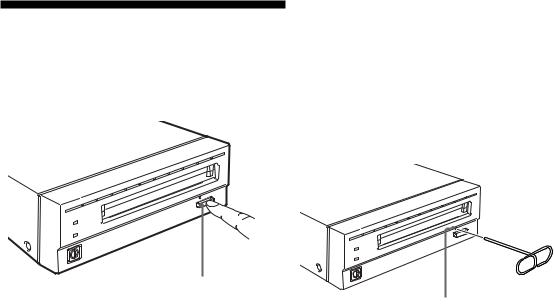
Ejecting a Disk Cartridge
Eject the disk cartridge either by using software commands or by pressing the EJECT button.
EJECT button
Note
Do not attempt to eject a disk cartridge while the BUSY indicator is lit orange (except when it is flashing at about 2-second intervals due to overheating). Ejecting the disk while it is being accessed may cause data write errors or may result in loss of data.
Also, it may take a few moments (up to 45 seconds) for the disk to eject when the write cache is enabled, because data in the cache must first be written to the disk.
■What to do if the disk does not eject
The disk cartridge may not come out, even when you press the EJECT button or use a software command, under the following conditions:
•The eject function has been disabled using the function switch or a software command;
•The host computer is not functioning properly;
•The disk unit has been turned off (due to a power failure, etc.); or
•Something is wrong with your disk unit itself.
When you cannot eject the disk cartridge using the EJECT button or software commands, remove it as follows.
1Turn off the disk unit if the power is still on.
2Insert the emergency eject tool (or a paper clip) straight into the emergency eject hole to trip the manual ejection mechanism.
Emergency eject Tool
Insert into the emergency eject hole.
This should cause the disk cartridge to eject.
Caution
The tip of the emergency eject tool is sharp. When handling the tool, please be careful to avoid injury.
12 Chapter 3 Using the Disk Unit

 Chapter 4 Precautions
Chapter 4 Precautions
On the Disk Unit
Safety Considerations
■ Power supply
•Be sure to use 100 - 240V AC.
•Do not share the AC outlet with any other power-consuming equipment such as copying machines or shredders.
■ AC power cord
•Be careful not to place or drop heavy object on the power cord, or subject it to anything that may damage it.
•When unplugging the cord from an AC outlet, be sure to grasp the plug itself. Pulling on the cord may cause damage to the internal wiring.
•Unplug the unit when not using it for long period of time.
■ Handling the emergency eject tool
The tip of the emergency eject tool is sharp. When handling the tool, please be careful to avoid injury. Do not use the tool for any purpose other than ejecting disks.
Damage Prevention
■Do not subject the disk unit to shock or vibration
Dropping the unit or subjecting it to strong impact may damage the disk unit.
■ Setting position
The disk unit is designed to be used in the horizontal position. Do not position it at an angle.
■ Location requirements
Careful consideration should be given to the following in selecting a site to install or store your disk unit.
Avoid the following conditions:
•High humidity
•High temperatures
•Direct sunlight
•Dust
•Strong vibration
•Wide temperature fluctuations
■ Ventilation
Care should be exercised to prevent the internal mechanisms of the disk unit from overheating. Be careful not to clog or block the vent, or place the unit in an area with poor ventilation. The disk unit may stop operating altogether if the internal temperature becomes too high.
■ Condensation
Avoid subjecting the disk unit to extremes in temperature. If, for example, the disk unit is moved suddenly from a very cold location to a warm one, moisture from condensation may form within the unit due to the quick rise in ambient temperature. If a sudden change in the temperature cannot be avoided, wait for an hour or more before using the disk unit. Inserting a disk cartridge into the mechanism when moisture is present may cause damage to both the disk and the disk unit. Remove the disk cartridge immediately if you suspect any condensation problems. The moisture should evaporate quickly if the disk unit is left on without a disk inserted.
Chapter 4 Precautions 13

■ Moving the disk unit
Be sure to remove the disk cartridge when the disk unit is not being used. Also never move or transport the unit with the disk cartridge still inserted.
While in operation, the disk rotates at a high speed. Moving the disk unit at such a time may disturb the spinning disk and cause it to be damaged. Always remove the disk cartridge before moving your disk unit.
■ If problems occur
If any problems occur, turn off the power and unplug the disk unit, contact your dealer.
Other Points Requiring Attention
■ Electrical noise
The high-frequency signal generated by the disk unit may cause interference or static on other electrical appliances such as radios, televisions and audio tuners. If this should occur, move the disk unit a little farther away from the affected appliance.
■ Maintenance
Clean the cabinet with a dry soft cloth, or with a soft cloth lightly moistened with a mild detergent solution. Do not use any type of solvent, such as alcohol or benzine, which may damage the finish.
On the Disk Cartridges
•Do not drop the disk cartridge or subject it to any violent shocks or vibration.
•Do not disassemble the disk cartridge. It is a precision component and has been carefully adjusted at the factory prior to shipment.
•Do not open the disk cartridge’s shutter manually or touch the disk inside. The shutter is designed to open automatically when the cartridge is inserted into the disk unit.
•Do not use the cartridge under ambient conditions of high humidity or wide temperature fluctuations. Moisture from condensation may make it impossible to read or write data.
•Avoid inserting and ejecting the disk cartridge more than is necessary.
•Always eject and remove the disk cartridge from the disk unit after using it.
■ Storing disk cartridges
•Store the disk cartridges in their cases.
•Do not leave the cartridges exposed to direct sunlight or excessive heat, like on the dashboard or in the glove compartment of an automobile. Do not store the disk cartridges under the following conditions.
–Excessive dust and debris
–Exposure to direct sunlight
–Near a heat source
–High humidity
14 Chapter 4 Precautions

Protecting Your Data
The magneto-optical disk cartridges are equipped with a DATA PROTECT switch (red tab) to prevent accidental erasure of data on the disk or inadvertent writing of unwanted data. Slide this switch in the direction of the arrow as illustrated below to enable the write protect function.
You can still read the data contained on the disk, but will not be allowed to write on or erase the disk. Return the switch to its original position to disable the write protect.
Make it a practice to leave the write protection enabled when you do not foresee the need to write on the disk.
DATA PROTECT switch
Cleaning
Cleaning a Disk
Dust and stains may accumulate on MO disks when they are used for a long period of time. To avoid resultant data read/write errors, use an optional disk cleaner. To maintain the high performance and prolong the useful life of your MO disk, cleaning at least once every three months is recommended.
■ Disk cleaning accessories
Use the following Sony disk cleaning kit or disk cleaner (sold separately).
• MOA-D51 Disk Cleaning Kit
Do not use any other type of disk cleaner as it may cause data read/write errors due to the differences in disk surface characteristics. For cleaning instructions, refer to the manual supplied with each cleaning accessory
Attention
In the disk unit, preventive measures are taken to guard against dust. It is unnecessary to clean the optical lens of your disk unit. Using a lens cleaning cartridge may damage the disk unit.
Chapter 4 Precautions 15

 Appendix
Appendix
Specifications
Disk Unit
■ Performance
Capacity Per disk
5.2 Gbytes (ZCAV 2,048 bytes/sector)
4.8 Gbytes (ZCAV 1,024 bytes/sector)
4.1 Gbytes (ZCAV 512 bytes/sector)
2.6 Gbytes (ZCAV 1,024 bytes/sector)
2.3 Gbytes (ZCAV 512 bytes/sector) Rotation speed
3,300 min–1 (3,300 rpm)
3,600 min–1 (3,600 rpm) Seek times (average)
25 ms (typical) User data transfer rate
Continuous transfer rate 2.48 – 5.07 Mbytes/s
(2,048 bytes/sector)
2.31 – 4.79 Mbytes/s
(1,024 bytes/sector)
1.97 – 4.06 Mbytes/s
(512 bytes/sector) Burst transfer rate
10 Mbytes/s (using Fast SCSI) Host interface
SCSI-2 (Small Computer System Interface-2) ANSI X3.131–1994
■ Operating environment
Installation Horizontal (±5°)
Temperature Operating
5 °C to 40 °C (41 °F to 104 °F) (gradient 10° C/h or 18 °F/h)
Non-operating
– 30 °C to 60 °C (– 22 °F to 140 °F) Relative humidity
Operating
10 % to 85 % (no condensation) Non-operating
10 % to 90 %
■ Laser
Type
Semiconductor AlGaInP laser Wavelength
685 nm ± 10 nm Maximum output
30mW
■Power supply and others
Power supply
100 – 240 V AC ±10%, 50/60 Hz ±5% Current drain
0.60 – 0.35 A max
Maximum external dimensions (excluding protruding parts and air duct)
211 × 70 × 293 mm (W/H/D)
(8 3/8 × 2 7/8 × 11 5/8 inches)
Weight
4.9 kg (10.9 lb.) Accessories
AC power cord (1) Emergency eject tool(1) User’s Guide (1)
MO Disk (1) Formatting Utility (1)
Design and specifications are subject to change without notice.
16 Appendix

Optional Accessories
MO disks
EDM-5200B (2,048 bytes/sector, 5.2 Gbytes) EDM-4800B (1,024 bytes/sector, 4.8 Gbytes) EDM-4100B (512 bytes/sector, 4.1Gbytes)
EDM-2600B (1,024 bytes/sector, 2.6 Gbytes) EDM-2300B (512 bytes/sector, 2.3 Gbytes)
Continuous composite write-once disks CWO-5200B (2,048 bytes/sector, 5.2 Gbytes) CWO-4800B (1,024 bytes/sector, 4.8 Gbytes) CWO-4100B (512 bytes/sector, 4.1 Gbytes) CWO-2600B (1,024 bytes/sector, 2.6 Gbytes) CWO-2300B (512 bytes/sector, 2.3 Gbytes)
Disk Cleaning Kit
MOA-D51
Appendix 17
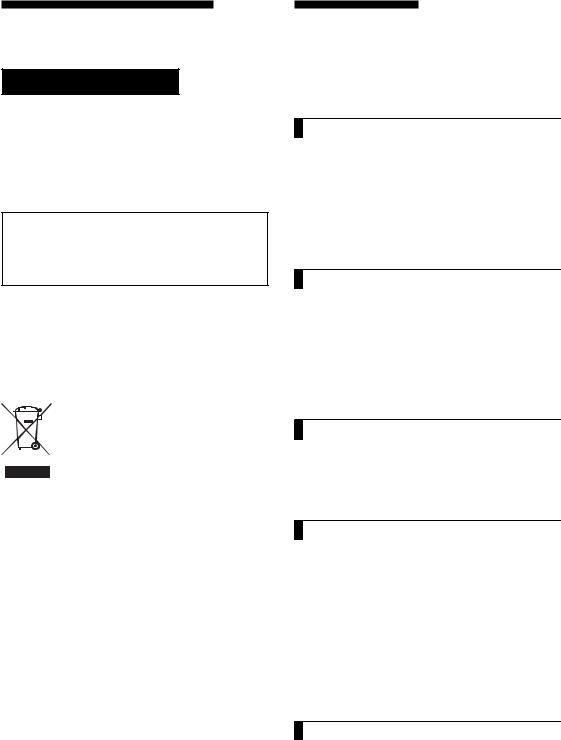
Règles de sécurité |
Sommaure |
AVERTISSEMENT
Afin de réduire les risques d’incendie ou de choc électrique, n’exposez pas cet appareil à la pluie ni à l’humidité.
Pour éviter toute électrocution, ne pas ouvrir le boîtier. Confier l’entretien à un technicien qualifié uniquement.
NOTICE
Utiliser le cordon d’alimentation approuvé par l’organisation de contrôle appropriée pour les pays auxquels le produit est destiné.
Traitement des appareils électriques et électroniques en fin de vie (Applicable dans les pays de l’Union Européenne et aux autres pays européens disposant de systèmes de collecte sélective)
Ce symbole, apposé sur le produit ou sur son emballage, indique que ce produit ne doit pas être traité avec les déchets ménagers. Il doit être remis à
un point de collecte approprié pour le recyclage des équipements
électriques et électroniques. En s’assurant que ce produit est bien mis au rebus de manière appropriée, vous aiderez à prévenir les conséquences négatives potentielles pour l’environnement et la santé humaine. Le recyclage des matériaux aidera à préserver les ressources naturelles. Pour toute information supplémentaire au sujet du recyclage de ce produit, vous pouvez contacter votre municipalité, votre déchetterie ou le magasin où vous avez acheté le produit.
Comment utiliser ce Guide..................... |
19 |
Chapitre 1 Introduction |
|
Aperçu ...................................................... |
20 |
Caractéristiques ........................................ |
20 |
Disques compatibles ................................. |
21 |
Configuration de système ......................... |
21 |
Localisation et fonction des pièces ...... |
22 |
Chapitre 2 Démarrage |
|
Liste de contrôle des composants et |
|
accessoires ...................................... |
23 |
Connexion du lecteur ............................. |
24 |
Réglage de l’adresse SCSI ..................... |
24 |
Réglage des fonctions du lecteur.......... |
25 |
Chapitre 3 Fonctionnement du lecteur |
|
Insertion d’une cartouche disque.......... |
26 |
Ejection d’une cartouche disque ........... |
27 |
Chapitre 4 Précautions |
|
A propos du lecteur ................................ |
28 |
Sécurité ..................................................... |
28 |
Prévention des dommages ........................ |
28 |
Autres points à prendre en compte ........... |
29 |
A propos des cartouches disques ........ |
29 |
Protection des données ............................. |
30 |
Entretien................................................... |
30 |
Nettoyage des disques .............................. |
30 |
Appendice |
|
Spécifications .......................................... |
31 |
Lecteur ...................................................... |
31 |
Accessoires en option ............................... |
32 |
18

Comment utiliser ce Guide
Ce guide couvre l’emploi et le fonctionnement du lecteur de disque magnéto-optique RMO-S551 (appelé par le suite le “lecteur”).
Ne pas essayer d’utiliser ce lecteur sans avoir préalablement lu attentivement ce guide. La lecture terminée, le garder à proximité pour toute référence ultérieure.
Ce guide se divise comme suit:
Chapitre 1 Introduction
Ce chapitre contient un aperçu général du lecteur RMO-S551, portant sur ses caractéristiques, la configuration du système, ainsi que la localisation et la fonction des pièces.
Chapitre 2 Démarrage
Ce chapitre explique comment raccorder ce lecteur à l’ordinateur central et aux autres périphériques SCSI. Il explique également le réglage de l’adresse SCSI et des fonctions du lecteur. Voir ce chapitre pour l’implantation du lecteur.
Chapitre 3 Fonctionnement du lecteur
Ce chapitre indique comment mettre le lecteur sous tension, et insérer et éjecter une cartouche disque. Se reporter à ce chapitre quand on est prêt à commencer à utiliser le lecteur.
Chapitre 4 Précautions
Ce chapitre contient les précautions concernant l’utilisation et le fonctionnement du lecteur et des cartouches disques magnéto-optiques.
Il couvre également le nettoyage des disques. Se reporter à ce chapitre avant d’utiliser le lecteur.
Appendice
L’appendice donne les spécifications principales du lecteur.
Remarques:
•Le fabricant décline toute responsabilité pour les pertes subies suite au mauvais fonctionnement ou à l’utilisation de ce produit.
•Le fabricant ne garantit pas la sécurité des données enregistrées en utilisant ce produit. Pour éviter toute perte accidentelle de données, une copie de sauvegarde fréquente est fortement recommandée.
•La reproduction du contenu de ce mode d’emploi, en totalité ou en partie, est interdite.
•Macintosh est une marque déposée de Apple Computer, Inc.
•Microsoft et Windows sont des marques déposées de Microsoft Corporation.
Français
19

 Chapitre 1 Introduction
Chapitre 1 Introduction
Aperçu
Caractéristiques
Le lecteur de disque magnéto-optique RMOS551 possède les caractéristiques suivantes:
•La technologie magnéto-optique permet l’écriture et l’effacement répétés de données sur le disque.
•Le lecteur de disque détecte automatiquement le type de disque en cours d’insertion, permettant ainsi d’employer indifféremment des disques de 650 Mo (594 Mo), 1,3 Go (1,2 Go), 2,6 Go (2,3 Go) et 5,2 Go (4,8 Go, 4,1 Go).
•5,2 Go (2.048 octets/secteur), 4,8 Go (1.024 octets/secteur), ou 4,1 Go (512 octets/secteur) maximum de donneés peuvent être écrites sur les deux côtés d’un disque magnéto-optique de 5,25 pouces, ce qui équivaut à environ 2900– 3700 fois la capacité d’une disquette conventionnelle de 3,5 pouces (2HD).
•Toute disquette conforme au format international CCS (servo continu/composite) ou CCW (écriture unique continu/composite) peut être utilisée dans cette unité de disquette.
•Ce lecteur de disque utilise SCSI-2 (Small Computer System Interface-2).
•Le moteur à broche grande vitesse 3.300 min-1 (3.300 tr/min.) permet la transmission des données à une vitesse de 2,48 - 5,07 Mo/s (2.048 octets/secteur), 2,31 - 4,79 Mo/s (1.024 octets/secteur), ou 1,97 - 4,06 Mo/s (512 octets/ secteur).
•Avec une capacité de disque inférieure à 2,6 Gbytes (2,3 Gbytes), le moteur fusiforme tourne à 3600 min-1 (tpm).
•Le lecteur optique profilé et léger offre un temps de recherche moyen de 25 ms.
•L’emploi d’un système de correction d’erreur hautement fiable (ECC) maintient les erreurs à un taux faible de 10-12.
•Un environnement de fonctionnement optimal est fourni par l’utilisation d’une large mémoire intermédiaire de 4 Mo et d’un algorithme de contrôle de mémoire-cache optimal. (La mémoire-cache d’écriture peut être activée ou désactivée. Pour plus d’informations, voir le réglage des fonctions du lecteur en page 25).
20 Chapitre 1 Introduction

Disques compatibles
Le RMO-S551 peut utiliser les disques magnéto-optiques de 5,25 pouces Sony suivants.
Standard |
Format du secteur |
Type* |
Capacité |
Equivalent Sony |
|
|
|
|
|
|
|
ISO/IEC 15286 |
2048 |
octets/secteur |
R/W |
Environ 5.2 Go |
EDM-5200B |
|
|
|
|
|
|
ISO/IEC 15286 |
1024 |
octets/secteur |
R/W |
Environ 4.8 Go |
EDM-4800B |
|
|
|
|
|
|
ISO/IEC 15286 |
512 |
octets/secteur |
R/W |
Environ 4.1 Go |
EDM-4100B |
|
|
|
|
|
|
ISO/IEC 14517 |
1024 |
octets/secteur |
R/W |
Environ 2.6 Go |
EDM-2600B |
|
|
|
|
|
|
ISO/IEC 14517 |
512 |
octets/secteur |
R/W |
Environ 2.3 Go |
EDM-2300B |
|
|
|
|
|
|
ISO/IEC 13549 |
1024 |
octets/secteur |
R |
Environ 1.3 Go |
EDM-1300B |
|
|
|
|
|
|
ISO/IEC 13549 |
512 |
octets/secteur |
R |
Environ 1.2 Go |
EDM-1200B |
|
|
|
|
|
|
ISO/IEC 10089 |
1024 |
octets/secteur |
R |
Environ 650 Mo |
EDM-650B |
|
|
|
|
|
|
ISO/IEC 10089 |
512 |
octets/secteur |
R |
Environ 600 Mo |
EDM-600B |
|
|
|
|
|
|
ISO/IEC 15286 |
2048 |
octets/secteur |
WO |
Environ 5.2 Go |
CWO-5200B |
|
|
|
|
|
|
ISO/IEC 15286 |
1024 |
octets/secteur |
WO |
Environ 4.8 Go |
CWO-4800B |
|
|
|
|
|
|
ISO/IEC 15286 |
512 |
octets/secteur |
WO |
Environ 4.1 Go |
CWO-4100B |
|
|
|
|
|
|
ISO/IEC 14517 |
1024 |
octets/secteur |
WO |
Environ 2.6 Go |
CWO-2600B |
|
|
|
|
|
|
ISO/IEC 14517 |
512 |
octets/secteur |
WO |
Environ 2.3 Go |
CWO-2300B |
|
|
|
|
|
|
ISO/IEC 13549 |
1024 |
octets/secteur |
R |
Environ 1.3 Go |
CWO-1300B |
|
|
|
|
|
|
ISO/IEC 13549 |
512 |
octets/secteur |
R |
Environ 1.2 Go |
CWO-1200B |
|
|
|
|
|
|
ISO/IEC 11560 |
1024 |
octets/secteur |
R |
Environ 650 Mo |
CWO-650B |
|
|
|
|
|
|
ISO/IEC 11560 |
512 |
octets/secteur |
R |
Environ 600 Mo |
CWO-600B |
|
|
|
|
|
|
* R/W : Réécriture possible, R/W: Ecriture multiple (MO), WO: Ecriture uniquement, R: Lecture uniquement
Configuration de système |
Sept périphériques maximum peuvent être reliés en |
|
chaîne sur le bus SCSI et contrôlés avec des |
||
|
||
Le lecteur doit être utilisé avec un ordinateur |
instructions SCSI-2. |
|
|
||
central équipé d’un SCSI. |
|
Ordinateur central
Câble SCSI
|
|
|
|
Lecteur RMO-S551 |
Péruphériques SCSI |
||
Chapitre 1 Introduction 21

Localisation et fonction des pièces
Panneau avant |
|
Panneau arrière |
1 |
A B C D E F G H |
AC IN |
|
||
BUSY |
|
SCSI ID |
0
POWER
SCSI CONNECTOR |
F.GND |
EJECT |
|
1 Interrupteur d’alimentation (POWER)
Appuyer sur la touche pour mettre sous/hors tension. L’appareil est sous tension quand la touche est enfoncée, et hors tension quand elle est sortie.
2 Témoin d’alimentation (POWER)
Le témoin vert s’allume à la mise sous tension.
3 Témoin d’occupation (BUSY)
Lorsque le disque est inséré et le lecteur est prêt pour l’opération de lecture/écriture, le témoin BUSY devient vert. Le témoin orange s’allume quand le lecteur accède au disque ou à l’écriture de données. Ce témoin clignotera à 2 secondes d’intervalle environ en cas de surchauffe, indépendamment de l’accès ou non à un disque.
4 Logement d’insertion de disque
Insérer la cartouche disque dans ce logement. Voir la section “Insertion d’une cartouche disque” à la page 26 pour de plus amples informations.
5 Trou d’éjection de secours
Si la cartouche disque ne peut être éjectée en utilisant la touche 6EJECT, mettre l’appareil hors tension et insérer l’outil d’éjection de secours dans la fente pour déclencher le mécanisme d’éjection de secours. Se reporter à la section “Que faire si la cartouche disque ne s’éjecte pas” en page 27 pour plus de détails.
6 Touche d’éjection (EJECT)
Appuyer sur cette touche pour éjecter la cartouche disque du lecteur.
La touche d’éjection est inhibée avec les sélecteurs de fonction ou un réglage logiciel interdisant l’éjection.
Lorsque la mémoire-cache d’écriture est activée, la disquette est éjectée après un moment (jusqu’à 45 secondes) car les données de la mémoire-cache doivent d’abord être écrites sur la disquette.
1 Sélecteurs de fonction
Les utiliser pour régler les fonctions du lecteur selon l’ordinateur central et le logiciel utilisés. Voir la section “Réglage des fonctions du lecteur” à la page 25 pour de plus amples informations.
2 Sélecteur d’adresse SCSI (SCSI ID)
L’utiliser pour poser l’adresse SCSI. Appuyer sur la touche “–” pour réduire le numéro ID, ou sur la touche “+” pour l’augmenter. Voir la section “Réglage de l’adresse SCSI” à la page 24 pour les détails.
3 Connecteurs SCSI
Brancher les câbles SCSI (vendus séparément) reliant l’ordinateur central et les autres périphériques dans ces connecteurs.
Remarque
Si le lecteur est le dernier appareil de la chaîne SCSI, régler le sélecteur de fonctions F sur “1” pour activer la terminaison interne. Dans le cas contraire, vérifier que la terminaison est désactivée (le sélecteur F est réglé sur “0”).
4 Manche à air
L’air pour refroidir le lecteur de disque passe dans cette manche. Faire très attention à ne pas bloquer sa surface et entraver la circulation.
5 Borne de terre de cadre (F.GND)
Connecter les bornes de mise à la terre des autres appareils à la borne de terre de cadre du lecteur.
6Connecteur d’alimentation secteur (AC IN)
Brancher le cordon d’alimentation secteur fourni dans ce connecteur.
22 Chapitre 1 Introduction
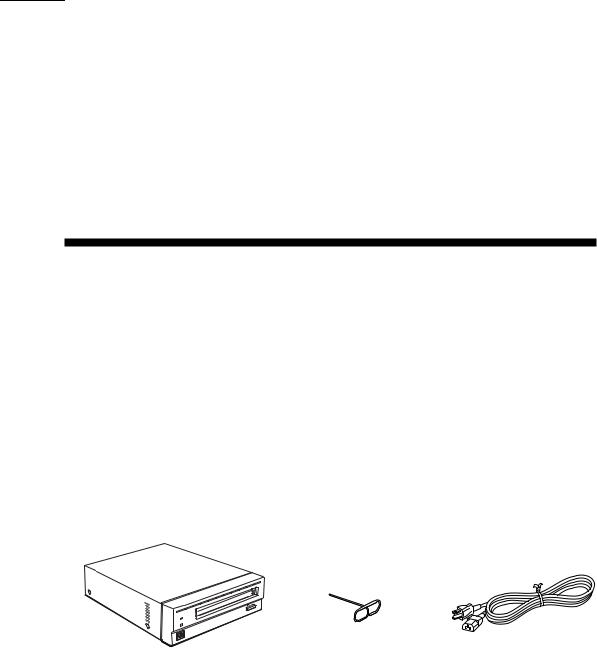
 Chapitre 2 Démarrage
Chapitre 2 Démarrage
Avant l’implantation du lecteur de disque magnéto-optique RMO-S551, vérifier que tous les composants et accessoires requis sont disponibles. Puis, connecter le lecteur à l’ordinateur central et aux autres périphériques
SCSI utilisés. Après la vérification des connexions, régler les fonctions du lecteur et son adresse SCSI ID à l’aide des sélecteurs de fonction.
Liste de contrôle des composants et accessoires
Ouvrir le carton et vérifier que tous les composants et accessoires indiqués ci-dessous s’y trouvent. Contacter immédiatement son revendeur si l’un d’entre eux manque ou est abîmé.
•Lecteur de disque magnéto-optique RMO-S551
•Cordon d’alimentation secteur
•Outil d’éjection de secours
•Mode d’emploi
•Guide d’utilisation de sécurité (Précautions de sécurité)
•1 disque MO vierge (EDM-5200B)
Remarque
Prière de se reporter au manuel d’installation inclu avec le gestionnaire de périphérique pour les instructions lors de l’utilisation de ce périphérique avec un ordinateur Macintosh® ou un ordinateur avec le système Windows®. Pour les questions concernant les gestionnaires de périphériques, prière de contacter le fabricant du gestionnaire de périphérique tel qu’indiqué dans le paquet.
Lecteure de disque magnéto- |
Outil d’éjection de secour |
Cordon d’alimentation secteur |
optique RMO-S551 |
|
|
|
|
|
Chapitre 2 Démarrage 23
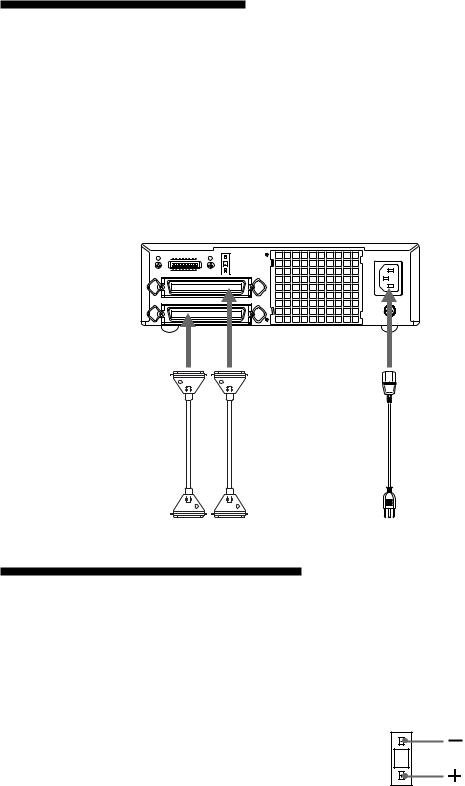
Connexion du lecteur
Sept périphériques SCSI maximum peuvent être reliés à un ordinateur central via son bus SCSI. Utiliser le câble SCSI de Sony suivant pour raccorder le lecteur.
Remarques
•Couper le lecteur et tous les autres appareils de la chaîne SCSI avant de connecter le lecteur.
•Si le lecteur est le dernier appareil de la chaîne SCSI, régler le sélecteur de fonction F du panneau arrière à “1” pour activer la terminaison interne. Si ce n’est pas le cas, vérifier que la terminaison est désactivée (sélecteur de fonction F réglé à “0”).
•La longueur totale des câbles SCSI connectés à une chaîne SCSI ne doit pas dépasser 6 mètres(19 pieds 8 1/4 pouces).
Lecteur de disque magnéto-optique RMO-S551
A B C D E F G H
1
SCSI ID
0
SCSI CONNECTOR
au connecteur SCSI |
AC IN
F.GND
au connecteur AC IN
Câble SCSI |
Câble SCSI |
Cordon d’alimentation |
|
|
sevteur(fourni) |
à un autre |
à l’ordinateur central ou à |
à une prise |
appareil SCSI |
un autre appareil SCSI |
secteur |
Réglage de l’adresse SCSI
Régler l’adresse SCSI du lecteur.
Le réglage usine par défaut de l’adresse SCSI est “0”. Si nécessaire, ce numéro ID peut être modifié au sélecteur SCSI ID du panneau arrière. Ne pas oublier de mettre l’appareil hors tension avant d’effectuer toute modification.
La pression de la touche “+” augmente le numéro ID, et celle de la touche
“–” le diminue.
Remarques
•Le lecteur ne fonctionnera correctement que si l’adresse SCSI a été réglée correctement.
•Vérifier que l’adresse SCSI sélectionnée n’a pas été affectée à un autre appareil SCSI.
0
24 Chapitre 2 Démarrage

Réglage des fonctions du lecteur
Sélectionner les fonctions du lecteur aux sélecteurs de fonction (A – H) du panneau arrière, selon l’ordinateur central et le logiciel utilisés. Bien mettre l’appareil hors tension avant d’effectuer ces réglages.
A B C D E F G H
1
0
L’unité de disquette est équipée d’une mémoirecache d’écriture. Lorsque la mémoire-cache d’écriture est activée, ne jamais mettre l’unité de disquette hors tension avant de s’assurer que toutes les données ont été écrites de la mémoirecache sur la disquette. Toutes les données seront perdues si l’unité est mise hors tension avant l’écriture de la mémoire-cache sur la disquette. S’assurer d’éjecter la disquette avant de mettre l’unité de disquette hors tension. En éjectant la disquette, les données sont écrites de la mémoirecache sur la disquette.
Remarque
Même si le lecteur envoie régulièrement les données au disque, les données risquent d’être perdues en cas de coupure de courant.
Réglages des sélecteurs de fonction
Sélecteur |
|
|
|
|
|
de |
Fonction |
|
|
|
|
1 |
0 |
|
|||
fonction |
|
|
|||
A |
Contrôle de parité |
Contrôle de parité SCSI |
Contrôle de parité SCSI valide. |
||
|
|
invalide. |
|
|
|
B |
Type de périphérique |
Type de périphérique 00H |
Type de périphérique 07H |
||
|
|
(Périphérique à accès direct) |
(Périphérique à mémoire optique) |
||
C |
Contrôle de mémoire- |
Mémoire-cache désactivée. |
Mémoire-cache activée. |
||
|
cache d’écriture |
|
|
|
|
D |
Contrôle SCSI rapide |
SCSI rapide compatible |
SCSI non rapide compatible |
||
E |
Vérification forcée. |
Toutes les opérations |
Toutes les opérations d’écriture |
||
|
|
d’écriture sont vérifiées. |
sont des opérations normales. |
||
|
|
(avec un passe de vérification) |
(sans passe de vérification) |
||
F |
Terminaison |
Terminaison interne activée. |
Terminaison interne désactivée. |
||
G |
Entraînement |
L’insertion d’un disque ne |
L’insertion d’un disque provoque la |
||
|
automatique |
provoque pas la rotation du |
rotation du moteur à broche. |
||
|
|
moteur à broche. |
|
|
|
H |
Ejection manuelle |
La cartouche de disque ne |
La cartouche de disque peut |
||
|
|
peut pas s’éjecter en appuyant |
s’éjecter en appuyant sur la touche |
||
|
|
sur la touche EJECT. |
EJECT. |
||
|
|
|
|
|
|
|
|
|
|
|
: Réglages usine |
|
|
|
|
|
|
Chapitre 2 Démarrage 25
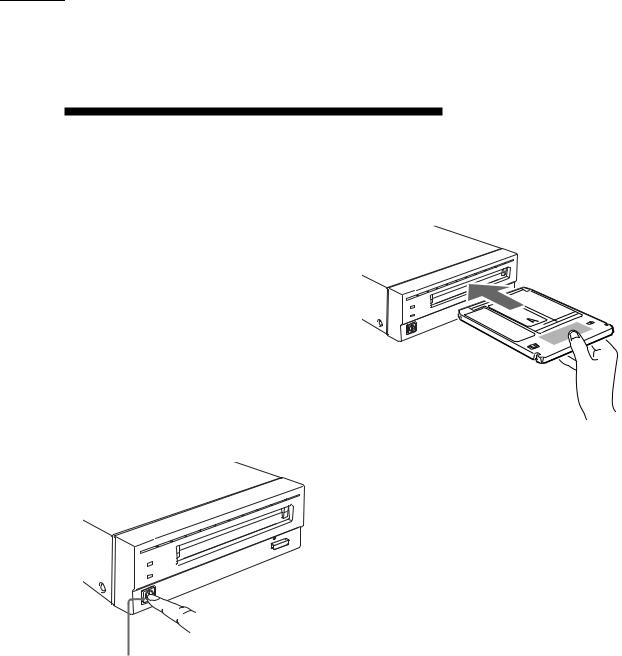
 Chapitre 3 Fonctionnement du lecteur
Chapitre 3 Fonctionnement du lecteur
Insertion d’une cartouche disque
Utiliser les disques magnéto-optiques de Sony 5,25 pouces suivants sur le lecteur RMO-S551.
•EDM-5200B (2.048 octets/secteur, 5,2 Go)
•EDM-4800B (1.024 octets/secteur, 4,8 Go)
•EDM-4100B (512 octets/secteur, 4,1 Go)
•EDM-2600B (1.024 octets/secteur, 2,6 Go)
•EDM-2300B (512 octets/secteur, 2,3 Go)
•CWO-5200B (2.048 octets/secteur, 5,2 Go)
•CWO-4800B (1.024 octets/secteur, 4,8 Go)
•CWO-4100B (512 octets/secteur, 4,1 Go)
•CWO-2600B (1.024 octets/secteur, 2,6 Go)
•CWO-2300B (512 octets/secteur, 2,3 Go)
1 Appuyer sur l’interrupteur POWER située sur le côtée gauche du panneau avant. Cela met le lecteur sous tension et provoque l’illumination du témoin POWER.
Appuyer sur
I’interrupteur POWER
2 Démarrer l’ordinateur central. Voir le mode d’emploi fourni avec
l’ordinateur central pour la procédure de démarrage.
3 Insérer une cartouche disque, la face à utiliser dirigée vers le haut.
Pour utiliser la face A, inserer le disque avec la face “A” dirigée vers le haut.
4Accéder ou écrire des données sur le disque
àl’aide d’instructions logicielles à l’ordinateur central. Le témoin BUSY s’allume durant l’accès au disque.
■Que faire quand le lecteur s’arrête de fonctionner
Quand la température du lecteur dépasse le niveau préréglé, le témoin BUSY se met à clignoter à 2 secondes d’intervalle environ indépendamment de l’accès à un disque ou non, et le lecteur s’arrête de fonctionner. Dans ce cas, il faut améliorer la ventilation de la zone de réglage.
Débrancher le lecteur s’il refuse toujours de fonctionner, et contacter son revendeur.
26 Chapitre 3 Fonctionnement du lecteur
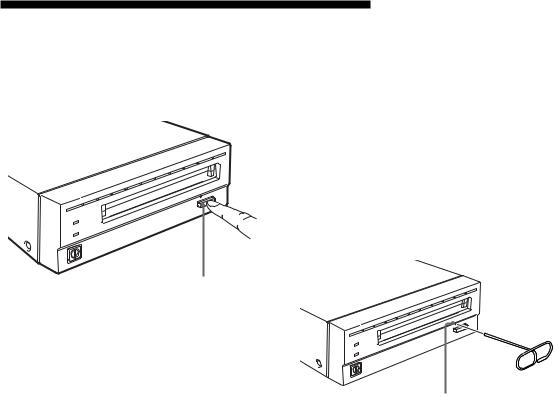
Ejection d’une cartouche disque
Ejecter la cartouche disque par instructions logicielles ou en appuyant sur la touche EJECT.
Procéder comme suit quand la cartouche disque ne peut pas être ejectée en appuyant sur la touche EJECT ou en utilisant des instructions logicielles.
1Mettre le lecteur hors tension s’il est encore sous tension.
2Insérer l’outil d’éjection de secours (ou un trombone) droit dans la fente d’éjection d’urgence pour déclencher le mécanisme d’éjection manuelle.
Touch
EJECT
Remarque
Ne pas essayer d’éjecter une cartouche disque quand le témoin BUSY est orange (sauf quand il clignote à 2 secondes d’intervalle environ pour cause de surchauffe). L’éjection du disque pendant son accès peut provoquer des erreurs d’écriture ou une perte de données.
La disquette est, aussi, éjectée après un moment (jusqu’à 45 secondes) lorsque la mémoire-cache d’écriture est activée, car les données de la mémoire-cache doivent d’abord être écrites sur la disquette.
■Que faire si la cartouche disque ne s’éjecte pas
Dans les conditions suivantes, la cartouche disque peut ne pas être projetée en avant, même si l’on appuie sur la touche EJECT ou si l’on utilise des instructions logicielles:
•La fonction d’éjection a été invalidée par un sélecteur de fonction ou une instruction logicielle.
•L’ordinateur central ne fonctionne pas correctement.
•Le lecteur a été coupé (par une panne d’électricité, etc.),
•Le lecteur lui-même a un problème.
Outil d’éjection de secours
Insérer dans le trou d’éjection de secours
Ceci devrait provoquer l’éjection de la cartouche disque.
Précaution
Le bout de l’outil d’éjection de secours est pointu. Faire très attention pour éviter toute blessure en manipulant l’outil.
Chapitre 3 Fonctionnement du lecteur 27

 Chapitre 4 Précautions
Chapitre 4 Précautions
A propos du lecteur
Sécurité
■ Alimentation
•S’assurer d’utiliser du CA 100 - 240 V.
•Ne pas brancher cet appareil sur la même sortie secteur qu’un autre appareil gros consommateur de courant, un copieur ou un destructeur de documents par exemple.
■ Cordon d’alimentation secteur
•Prendre garde de ne pas placer ni laisser tomber d’objets lourds sur le cordon d’alimentation, ou de l’endommager de quelque manière que ce soit.
•Pour débrancher le cordon de la prise secteur, bien le saisir par la fiche elle-même. Tirer sur le cordon risque d’endommager le câblage interne.
•Débrancher l’appareil s’il doit rester inutilisé durant une période prolongée.
■Manipulation de l’outil d’éjection de secours
Le bout de l’outil d’éjection de secours est pointu. Faire très attention pour éviter toute blessure en manipulant l’outil. N’utiliser l’outil que pour l’éjection des disques.
Prévention des dommages
■Ne pas soumettre le lecteur à des chocs ou à la vibration
Le lecteur risque d’être endommagé s’il tombe ou s’il est soumis à de forts impacts.
■ Position d’installation
Le lecteur est conçu pour être utilisé horizontalement. Ne pas l’installer de biais.
■Exigences concernant l’emplacement
Tenir compte des points suivants lors de la sélection de l’emplacement d’installation ou de stockage du lecteur.
Eviter les conditions suivantes:
•Forte humidité
•Hautes températures
•En plein soleil
•Poussière
•Forte vibration
•Fluctuations de température importantes
■ Ventilation
Prendre les précautions nécessaires pour éviter la surchauffe des mécanismes internes du lecteur. Veiller à ne pas obstruer ni bloquer les trous d’aération, ni placer l’appareil dans un endroit mal aéré. Le lecteur de disque peut s’arrêter de fonctionner si la température interne devient trop élevée.
■ Condensation
Eviter de soumettre le lecteur à des températures extrêmes. Ainsi, s’il est brusquement déplacé d’un endroit froid à un endroit chaud, de l’humidité peut se condenser à l’intérieur à cause de la soudaine augmentation de la température ambiante. Si un brusque changement de température ne peut pas être évité, attendre une heure au moins avant d’utiliser le lecteur. L’insertion d’une cartouche disque dans le mécanisme alors qu’il y a de l’humidité risque d’endommager à la fois le disque et le lecteur. Retirer immédiatement la cartouche disque si l’on suspecte un problème de condensation. L’humidité devrait s’évaporer rapidement si le lecteur est laissé sous tension sans insertion de disque.
28 Chapitre 4 Précautions

■ Déplacement du lecteur
Ne pas oublier de retirer la cartouche disque quand le lecteur n’est pas utilisé. Ne jamais déplacer ou transporter l’appareil avec une cassette disque à l’intérieur. En fonctionnement, le disque tourne à grande vitesse. Le déplacement du lecteur à ce moment-là risque de déranger le disque en rotation et de l’endommager. Toujours retirer la cartouche disque avant de déplacer le lecteur.
■ En cas de problème
En cas de problème, couper l’alimentation, débrancher le lecteur, et contacter son revendeur.
Autres points à prendre en compte
■ Parasites
Le signal de hautes fréquences produit par le lecteur peut provoquer des interférences ou de l’électricité statique sur d’autres appareils électriques, tels que poste radio, téléviseur et tuner audio. Dans ce cas, éloigner un peu plus le lecteur de l’appareil affecté.
■ Entretien
Nettoyer le coffret avec un chiffon doux et sec, ou un chiffon doux légèrement humecté de solution détergente douce. Ne pas utiliser de solvant, tel que l’alcool ou la benzine; il pourrait abîmer la finition.
A propos des cartouches disques
•Ne pas laisser tomber la cartouche disque ni la soumettre à des chocs ou vibrations violents.
•Ne pas démonter la cartouche disque. C’est un composant de précision, qui a été minutieusement réglé à l’usine avant son expédition.
•Ne pas ouvrir le volet de la cartouche disque à la main ni toucher le disque à l’intérieur. Le volet est conçu pour s’ouvrir automatiquement à l’insertion de la cartouche dans le lecteur.
•Ne pas utiliser la cartouche dans des conditions ambiantes de forte humidité ou d’importantes fluctuations de température. L’humidité due à la condensation peut rendre la lecture ou l’écriture des données impossible.
•Eviter d’insérer et d’éjecter la cartouche disque plus souvent que nécessaire.
•Toujours éjecter et retirer la cartouche disque du lecteur après son utilisation.
■Rangement des cartouches disques
•Ranger les cartouches disques dans leur boîte.
•Ne pas les laisser en plein soleil ou sous une chaleur excessive, sur le tableau de bord ou dans la boîte à gants d’une voiture par exemple. Ne pas ranger les cartouches disques dans les conditions suivantes:
–Poussière excessive et débris
–En plein soleil
–Près d’une source de chaleur
–Forte humidité
Chapitre 4 Précautions 29
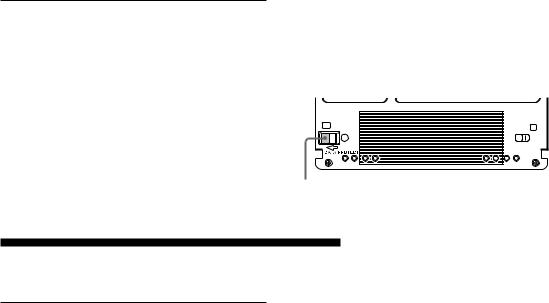
Protection des données
Les cartouches disques magnéto-optiques sont équipées d’un curseur DATA PROTECT (ergot rouge) pour éviter tout effacement accidentel des données du disque ou écriture par inadvertance de données non souhaitées. Glisser ce curseur vers la gauche comme le montre l’illustration cidessous pour valider la fonction de protection contre l’écriture. Il sera toujours possible de lire les données du disque, mais l’écriture ou l’effacement du disque seront impossibles.
Ramener le curseur à sa position d’origine pour invalider la protection contre l’écriture. S’habituer à laisser la protection contre l’écriture validée quand on ne prévoit pas d’écrire sur le disque.
Curseur
DATA PROTECT
Entretien
Nettoyage des disques
La poussière et les taches peuvent s’accumuler sur les disques magnéto-optiques quand ils sont employés durant de longues périodes. Utiliser un dispositif de nettoyage de disque en option pour éviter les erreurs de lecture/écriture en résultant. Il est recommandé de nettoyer les disques MO au moins une fois tous les trois mois pour leur conserver leurs bonnes performances et prolonger leur longévité.
■Accessoires de nettoyage de disque
Utiliser le kit de nettoyage de disque ou le dispositif de nettoyage de disque Sony (vendus séparément) suivants:
• Kit de nettoyage de disque MOA-D51
Ne pas utiliser d’autre dispositif de nettoyage de disque, cela pourrait provoquer des erreurs d’écriture/lecture des données dues aux différences de caractéristiques de la surface des disques. Voir le mode d’emploi fourni avec chaque accessoire de nettoyage pour les instructions sur le nettoyage.
Attention:
Dans le lecteur de disque, des mesures préventives sont prises pour le protéger de la poussière. Il est nécessaire de nettoyer la lentille optique du lecteur. L’utilisation d’une cassette de nettoyage de lentille risque d’endommager le lecteur de disque.
30 Chapitre 4 Précautions
